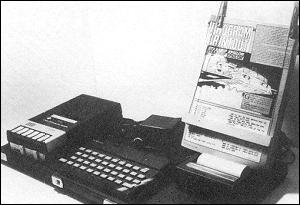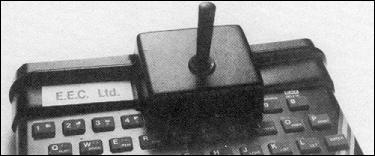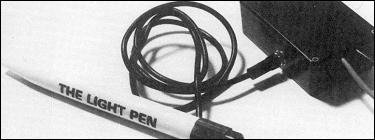| Hardware World |

MOST COMPUTER hardware falls into one of two categories. Either it is a marvel of modern science or, as is unfortunately too often the case, it is over-priced and unnecessary. The Fatherboard, marketed by Censcot, could be said to be in a category of its own.
It could not be said to be visually impressive but it does what it was designed to do remarkably well. It is a board on which a computer and all its peripherals can be put securely so that they can be moved as a unit. It has an ingenious method of holding a listing so that it can be typed in comfort.
The main board measures 30cm. by 60.5cm. overall with rubber feet on the bottom and back edge. Into that is inlaid a piece of pegboard 27.5cm. x 58cm. - with enlarged holes at strategic points. That is first removed. The computer, tape deck and any other items are laid out and then tied to the board using the wire supplied. There are also bolts to act as anchor points.
All the leads can then be threaded through the bigger holes and any slack hidden underneath. The pegboard is then replaced in the main board and screwed into place. Also supplied is a nylon dust cover which fits over the board with a hole at the front to allow access to the carrying handle on the main board. As everything is secured to the board it can be carried and stored vertically.
The copyholder is a board which is secured vertically to any two holes on the pegboard. On to that the moving cursor is fitted. That is two clothes pegs through which a piece of string has been threaded. Tied to the string are two pieces of wood. When properly arranged, one piece of wood can be moved up and down to keep track of where you are in your listing.
If you have sat on the edge of an armchair in front of the family TV with a computer on one knee and a magazine on the other trying to type in a listing surrounded by wires and pieces of computer, only to be told to clear everything away, then you can see how useful the Fatherboard could be. It may not be much to look at but it is well-thought-out.
Fatherboard is marketed by Censcot, Stirling, Scotland. It costs £17.50 plus £1.50 p&p.
A NEW floppy disc interface from Technology Research has now been upgraded further to allow you to LOAD and SAVE variables. By preceding the save name with a # all the variables will be saved. In addition, when SAVEing a program the variables are saved with it and when auto-run on LOADing it then does a GO TO 1 rather than RUN, which would have CLEARed the variables.
It is pleasant to see a company which is always trying to improve its products, especially as, in this case, it will cost no extra.
Details from Technology Research, London.
KELAN, or rather its trade name Hobbyboard, is well-known among hobbyists as a supplier of hardware and complete kits. Its latest offering is a prototyping kit which can be used for the ZX-81, Spectrum or Jupiter Ace. The kit - part No. HB/2090 - will give a professional finish to any project and can be used for many of the designs in Sinclair Projects.
In each kit are a prototype PCB, with space for 10 16-pin ICs - or perhaps 12 - and a Veroboard scratch pad, a Spectrum-style 28-way edge connector - that can be cut down for use on other machines - an extender card, a 9-pin D-type, Atari-style PCB mounting socket, and a case in which to put it all. Case screws are included.
Costing £9.50 inc., the kit is very good value. Contact Kelan (Hobbyboard), North Yorkshire.

REGULAR READERS of Hardware World may remember the mechanical joystick reviewed in the February issue. New from EEC Ltd is another joystick which clips over the Spectrum case and presses the 5, 6, 7 and 8 cursor keys mechanically in response to the movement of the stick.
The casing is a one-piece moulding which fits very snugly to the Spectrum case. Inside that the stick is joined securely to a shaped plate which then presses down on one or more levers to depress the key. The design appears to be well-thought-out, with attention paid to its strength.
A previous criticism of this type of joystick was that it would work only with games configured to use the cursor keys and that is still so but EEC includes details of more than 60 games which can be played with the joystick.
Retailing at £9.95, or from EEC with an extra 55 pence postage, the joystick is competitively priced.
WHEN CREATING designs on Sinclair machines, a piece of graph paper is invaluable but its only disadvantage is that most commercial paper has a 10 x 10 grid. The Data Design Pad solves the problem by providing two different grids. The first has 22 squares by 32 and is ideal for designing a screen layout using individual characters. The second has 24 squares in a 6 x 4 pattern, each square being further divided into an 8 x 8 grid, and can be used for individual user-defined graphics or larger designs. Every pad has 50 sheets, each sheet having one of the former and four of the latter grids.
At £4.60 for one, £7.70 for two and £10.70 for three pads, all inc., they are by no means inexpensive, but can save a good deal of time. They are available from TRT Designs, London.
NEW from PDQ Software is the Galaxy dust cover for the Spectrum. Made in a metallic blue PVC with a silver flash, the cover provides an attractive means of keeping a computer clean. There is even a cut-out on the back of the cover to enable you to leave all the leads and any add-ons plugged-in.
Priced at £1.75 inc., the dust cover is available by mail order from PDQ Software, Kent.

AMONG Add-On Electronics hardware is a light pen for the Spectrum, a device which, when pointed at the TV screen, can indicate to the computer where the pen is pointing. Included in the software provided with the pen are 16 routines to allow you to draw pictures using the facility.
The light pen is in two parts, the pen and, second, a small box containing the electronics into which it is plugged. The Spectrum power supply is then plugged into the side of the box and another lead is plugged into the Spectrum power socket. Once the software tape has been loaded the other lead from the box is plugged into the Spectrum EAR socket and you can use the pen to run the program.
A television set works by moving an electron gun across the screen and where the electrons fall the phosphor on the screen will glow. To make up a picture the gun starts pointing at the top left of the screen and then moves down in a zig-zag fashion making, on a modern TV, 625 sweeps across the screen. It does that 25 times per second. If you know when the gun starts scanning the screen you can time how long it takes to reach any given point.
Inside the light pen is a BPW148 photo-transistor with one leg cut off. When light falls on it a current passes through it. The software enables the computer to measure the time between the electron gun starting a new scan and the light pen passing a current. The time interval shows at what point on the screen the pen is being pointed.
Obviously the timing is critical and here the software fails to do its job. It was almost impossible to use the program provided as, when picking from the menu, the pen would be pointed at the chosen square, but the software assumed it was being pointed up to 2in. to the left, choosing another menu selection.
If it had been consistent, that problem could have been overcome but the error varied according to the area of screen selected and by a random element. The instructions provided with the pen give a short Basic program to allow you to adjust your set to the pen. That did not solve the problem. The error may be due to the television set used and may not occur on all sets. If possible, borrow a pen from a friend and try it before buying.
It is interesting to note that the instructions mention there being a fine control on the light pen box when there is none, either externally or internally, on the printed circuit board.
The only other light pen with that control is one made by DK'Tronics, which shares the same address as Add-On Electronics. To confuse the issue further the software cassette with the pen bears a copyright notice from a now defunct company, Kayde, and the picture on the light pen box is the same as that used in Kayde advertising.
Both the other light pens sold for £10 less than the Add-On Electronics version.
At £30 the pen can be obtained from Add-On Electronics, Essex.